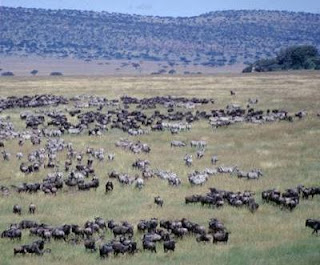
Savanna, also savannah, tropical grassland with a scattering of shrubs and small and large trees. Savannas may result from soil conditions, from periodic fires caused by lightning or set by humans, or from climatic influences.
Climatically determined savannas, as found in western and southwestern Africa, develop in regions with marked wet and dry seasons, where rainfall ranges between 100 and 400 mm (4 and 16 in) a year. These savannas vary from open-canopied forests with a grassy understory to true savannas in which grasses are dominant. When the rainfall is 100 to 200 mm (4 to 8 in), generally only grasses can survive the dry season. When rainfall reaches 300 mm (12 in), the soil holds enough water to sustain shrubs through the dry season as well. When rainfall exceeds 300 mm, enough water is left to support solitary trees; and when rainfall exceeds 400 mm, enough moisture remains during the dry season to allow trees to grow more densely and to form a canopy, shading out the grasses.
In regions of higher rainfall, such as eastern Africa, savanna vegetation is maintained by periodic fires. Consuming dry grass at the end of the rainy season, the fires burn back the forest vegetation, check the invasion of trees and shrubs, and stimulate new grass growth. These savannas are also influenced by large grazing mammals such as wildebeest and zebra. When abundant, the animals can so reduce the vegetation that the grassy cover cannot carry a fire. Woody vegetation then increases, changing savanna to woodland. Such woody growth can be reduced, in turn, by large browsers such as elephants.
Soil-determined savannas include the llanos of Venezuela and the campos cerrados of Brazil. The latter are characterized by a hard crust in the soil, formed by ferric oxides. Grasses grow in the soil above the crust; trees grow where roots, following cracks in the crust, can reach deeper groundwater.
Climatically determined savannas, as found in western and southwestern Africa, develop in regions with marked wet and dry seasons, where rainfall ranges between 100 and 400 mm (4 and 16 in) a year. These savannas vary from open-canopied forests with a grassy understory to true savannas in which grasses are dominant. When the rainfall is 100 to 200 mm (4 to 8 in), generally only grasses can survive the dry season. When rainfall reaches 300 mm (12 in), the soil holds enough water to sustain shrubs through the dry season as well. When rainfall exceeds 300 mm, enough water is left to support solitary trees; and when rainfall exceeds 400 mm, enough moisture remains during the dry season to allow trees to grow more densely and to form a canopy, shading out the grasses.
In regions of higher rainfall, such as eastern Africa, savanna vegetation is maintained by periodic fires. Consuming dry grass at the end of the rainy season, the fires burn back the forest vegetation, check the invasion of trees and shrubs, and stimulate new grass growth. These savannas are also influenced by large grazing mammals such as wildebeest and zebra. When abundant, the animals can so reduce the vegetation that the grassy cover cannot carry a fire. Woody vegetation then increases, changing savanna to woodland. Such woody growth can be reduced, in turn, by large browsers such as elephants.
Soil-determined savannas include the llanos of Venezuela and the campos cerrados of Brazil. The latter are characterized by a hard crust in the soil, formed by ferric oxides. Grasses grow in the soil above the crust; trees grow where roots, following cracks in the crust, can reach deeper groundwater.